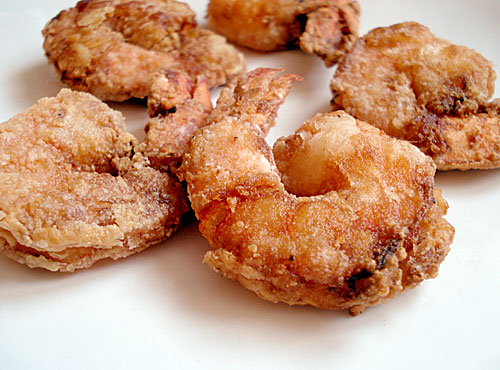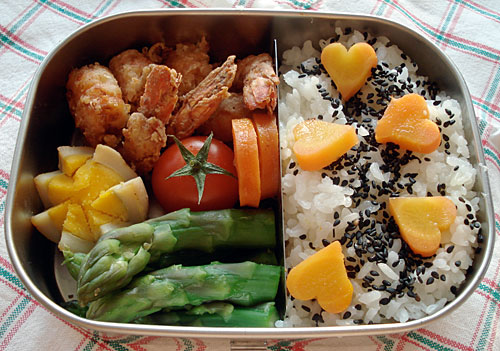Shrimp Tatsutaage: Japanese Crispy Fried Shrimp

These light and crispy shrimp are fairly low in calories, even though they are fried. You only need about 1 cm / 1/2 an inch of oil to fry these in a regular frying pan, so don't be afraid to try them even if you don't do much deep-frying. They are very easy to make with frozen shrimp, and just a bit more work with fresh shrimp.
Recipe: Shrimp Tatsuaage
Adapted from a recipe in Today's Cooking: Beginners magazine. Each shrimp is about 30-40 calories depending on how well you drain off the oil.
- 12 medium shrimp, shelled and de-veined, with their tails still on if you can manage it, or frozen uncooked shrimp
- 2 Tbs. soy sauce
- 1 Tbs. mirin (or substitute sake or sherry with a pinch of sugar. I prefer to use mirin here over sake, since the sweetness matches well with the shrimp.)
- 1 tsp. grated ginger
- Cornstarch or potato starch (katakuriko)
- Oil for frying
- Sansho pepper or black pepper (optional)
Prepare your shrimp. If you're using frozen shrimp defrost them beforehand. (Leave them in the refrigerator overnight, or microwave them on DEFROST for 2-3 minutes. Don't let them get cooked while you're defrosting them.You can proceed with the marinating even if the shrimp are a bit frosty. ) I like to leave the tails on for appearance and flavor - they get crispy and crunchy enough that you can eat them too.
Combine the soy sauce, mirin, sake and grated ginger in a bowl. Put the shrimp in there, and let marinade for 5-10 minutes. I prefer not to let them marinate for too long, since it sort of kills the shrimp flavor, but you may prefer a longer marinade.
Drain away the liquid. Toss the shrimp in enough cornstarch or potato starch to coat them completely.
Heat up about 1/2 an inch (1 cm) of vegetable oil (I use peanut oil or canola oil or rapeseed oil) in a frying pan. Put the shrimp in in one layer, not overcrowding the pan. Fry for a couple of minutes, then turn over and fry for an additional 2-3 minutes, until they are a reddish golden-brown. Drain the oil well on a rack or on paper towels.
Sprinkle with sansho pepper or freshly ground black pepper before serving.
These are delicious hot or cold. If you're using them in a bento, let them cool down completely before packing, and they should stay crispy until lunchtime. You may want to add a dipping sauce, but I find it unnecessary since the shrimp are already seasoned well.
Deep fried stuff in a healthy bento?
Sure, if you balance it out with non-fried food, as I did in this bento, which has just 4 shrimp (120 calories):

Fried food in small amounts is more filling and satisfying, as opposed to only eating food that's boiled, steamed, or raw or whatever. Of course if you are feeding a teenager or an athlete, you can really fill them up with fried food.
Tatsutaage or karaage?
Long time readers of Just Bento and Just Hungry may notice that the marinade and method is very similar to the one for Chicken Karaage. The -age (pronounced ah-GEH) means 'deep fried'. So what's the difference between karaage (唐揚げ) and tatsutaage (竜田揚げ)? Not much really, except that 'karaage' is used for several kinds of deep fried dishes that are coated in a flour, while 'tatsutaage' means something that is marinated, coated with flour of some kind and fried. Either kind of frying method is excellent for bentos. (Incidentally I've seen it stated on the interweb that karaage means 'sesame fried chicken'. That is false information. Sesame fried chicken is called 'gomaage' - sesame-fry.)
If you enjoyed this article, please consider supporting this site by becoming my patron via Patreon.
